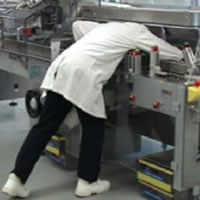
Does looking at this picture make you very uneasy about the fate of the worker’s head and hands’

Industrial machinery and equipment pose serious safety hazards to the workers who operate them. For example, if they aren’t adequately guarded to protect workers from accessing pinchpoints, energized parts and other hazards, workers who contact these hazards can lose a finger, limb or even their lives.
And even when machinery has appropriate guards, workers should still turn off the equipment and lock it out before they stick their hands’or their heads’into dangerous areas, say, to clear a jam or adjust material.
It’s unclear whether the worker in this picture has followed his company’s lockout policy and procedures. If not, the consequences could be tragic. For example, the most common injuries reported relating to lockout violations include crushing injuries and amputations.
8 MACHINE SAFETY DOs & DON’Ts
There are eight things workers should do/not do to ensure they’re safe when using machinery or equipment:
DO read all warnings on the machine before operating it.
DON’T operate or even go near machines unless they’re trained and authorized to do so.
DO check all motion control switches at least once a day.
DON’T operate a machine unless and until they’ve verified that all machine guards, interlocks and other safety devices are in place and working properly.
DO let the machine and all moving parts come to a complete stop before touching the machine or those parts. (Here’s what can happen if they don’t wait: A worker at a car manufacturing plant tried to clear a clog in a machine with a large spiked roller. Although he locked out the machine before opening an access window to reach the clog, the roller was still moving. His hand got caught by it and he was drawn into the machine, suffering serious injuries. The manufacturer pleaded guilty to an OHS violation and was fined it $120,000 [Rieter Automotive Mastico Ltd., Ontario Govt. News Release, May 13, 2011].)
DON’T operate machines with electrical cabinets or safety door enclosures open.
DO use extra guards if necessary.
DON’T perform service, maintenance or repairs on machines unless they’re properly de-energized under the lockout program.
The OHS Insider has articles, tools and other resources that can help you ensure that workers are safe when using, repairing or otherwise operating the machinery and equipment in your workplace, including :
- How to comply with the group lockout requirements
- Troubleshooting machinery and equipment
